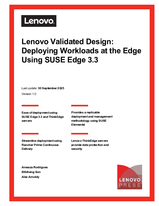Published
30 Sep 2025Form Number
LP2308PDF size
39 pages, 1.7 MBAbstract
This Lenovo Validated Design describes deploying Kubernetes workloads at the edge using SUSE Edge 3.3 on Lenovo ThinkEdge servers. It outlines a scalable, secure, and low-touch methodology for provisioning and managing edge infrastructure across distributed environments. The solution leverages SUSE Elemental for automated OS and Kubernetes deployment and Rancher Prime Continuous Delivery for GitOps-based application lifecycle management.
Key challenges addressed include limited on-site technical expertise, complex logistics, physical security vulnerabilities, and constrained connectivity. The architecture decouples deployment phases, enabling independent progress of hardware, OS, and application layers, thus improving agility and reducing time-to-value. Enhanced security is ensured through hardware-based encryption, tamper detection, and UEFI/XClarity Controller hardening.
This guide is intended for edge solution architects and demonstrates how to achieve friction-free logistics, resilient workloads, and automated application delivery at scale, making it a replicable model for modern edge computing initiatives.
Table of Contents
1. Introduction
2. Business Challenges and Key Benefits
3. Architectural Overview
4. Enhanced Security at the Edge
5. Secure Hardening Recommendation
6. Edge Deployment
7. Conclusion
8. Appendix: Lenovo ThinkEdge Security Features
9. References
Trademarks and special notices
Document history
Related product families
To view the document, click the Download PDF button.
Configure and Buy
Full Change History
Course Detail
Employees Only Content
The content in this document with a is only visible to employees who are logged in. Logon using your Lenovo ITcode and password via Lenovo single-signon (SSO).
The author of the document has determined that this content is classified as Lenovo Internal and should not be normally be made available to people who are not employees or contractors. This includes partners, customers, and competitors. The reasons may vary and you should reach out to the authors of the document for clarification, if needed. Be cautious about sharing this content with others as it may contain sensitive information.
Any visitor to the Lenovo Press web site who is not logged on will not be able to see this employee-only content. This content is excluded from search engine indexes and will not appear in any search results.
For all users, including logged-in employees, this employee-only content does not appear in the PDF version of this document.
This functionality is cookie based. The web site will normally remember your login state between browser sessions, however, if you clear cookies at the end of a session or work in an Incognito/Private browser window, then you will need to log in each time.
If you have any questions about this feature of the Lenovo Press web, please email David Watts at dwatts@lenovo.com.

